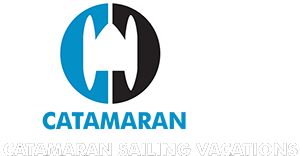
by Steve Varrow, RYA, IYT and ASA sailing instructor and charter Captain in the BVI
During my time, sailing, teaching and skippering boats in the Caribbean, and most recently the BVI, I have noticed a recurring theme with some bareboat skippers and the common mistakes that can be made. In an effort to help you avoid some common mistakes, I have written down my top 10 tips to help you get through the week with the minimum of drama, or how not to be a Bad Captain!
Top 10 tips for a successful BVI bareboat charter vacation:
Don’t Overestimate Your Abilities:
Most accidents in the BVI waters are caused by human error. Charter the size of boat you are comfortable with. Do not fall into the trap of hiring a much bigger boat than you are used to and inviting your friends and family in as an effort to reduce your overall costs. It can end in disaster if you overstretch your abilities as skipper. Sailing a new boat can be stressful and the last thing you need is brother Charlie (who does not like boats or you) commenting “does he know what he is doing?!” while you are trying to navigate onto the fuel dock in 20+ knots of breeze.
If you are taking on a boat that you are not familiar with there is no shame in taking a checkout skipper for the first day. His job will be to make sure you know how to use all the systems on the boat, secure the boat safely at night and make it to the next anchorage without any dramas. Make good use of the time with him. He is not the enemy, but there to help you make the most of your vacation.
Boat Briefing:
DO NOT rush through the boat briefing, even if you have chartered the same vessel before! Boat systems can be complicated. Sometimes they change and are upgraded so it’s very important to take your time to digest all the information coming in during your briefing. Take notes. Even better, record everything on video so you can play it back later. Have a second person present during the briefing so nothing is missed. Most calls to the charter base in the first few days are for questions that have been missed on the charter brief. If you rush through the brief you are asking for trouble!
Remember that the guy doing the briefing probably does this every day of the week. Do not just nod if you do not understand his explanation. Ask questions if you are not sure. In my time as a checkout skipper, I could easily judge the guys that would be running into trouble. It would usually be the ones staring at you like a frightened rabbit as you asked them to repeat the process you just explained to them. If in doubt – check. A good idea once you have been briefed is to go over everything with your number two. If you are both not sure how something works, ask again. Do not be afraid to be a pain in the neck. Your boat briefer will be happy to go over things now rather than dinghying over to Peter Island at 4PM to flip your windlass breaker that he showed you the location of on the dock.
Preparation:
I cannot stress enough the benefit of prior planning and preparation. Before you arrive in the BVI for your charter, I am sure you will have spent weeks researching your overall passage plans, laying out your itinerary, checking Facebook groups and constantly monitoring the forecast in advance of your trip. Prior planning of your trip is a great start and something everyone should do, but there is a caveat, things can change rapidly in the tropics depending on the time of year that you visit, and the plan that you made three months ago may need to be revisited closer to the time. An example could be that during the Winter months violent storms far away on the East coast of the US can create big North swells (swell is defined by the direction it is going, wind is defined by the direction it is coming from). These swells can make the Northerly exposed anchorages in the BVI untenable and even dangerous and potentially the southern anchorages of Jost Van Dyke when the swell is reflected off the North coast of Tortola as well.
In this instance there may be a need to modify your weeks plan accordingly and avoid the Northern shores of the BVI Islands. My advice would be to make your overall plan, and once you have an up-to-date forecast, decide on your anchorage for the first two nights. Then revisit the plan on a daily basis taking into consideration the prevailing conditions. If everything stays as forecasted, follow your plan and enjoy your trip. The worst type of skipper is the skipper that sticks to his pre-planned route whatever the conditions and puts his crew in danger. This can be avoided by the Captain giving an overall summary of the trip and keeping the specifics of each day flexible and then making the decisions on where to go next subject to the prevailing decisions. This way everyone is happy that you are in charge of the situation and not just carrying on regardless. Tick off all the boxes you have promised if possible but be flexible in your approach, that way you will have happy crew and a happy boat.
Passage Planning
It’s very easy just to turn on your chart plotter after breakfast, drop in a few waypoints and head off to your next destination without a care in the world. A word of caution though, most people drive over the top of reefs by mis-reading chart plotting information or missing important information on the charts. As a rule, reefs do not move around and the BVI has pretty accurate charted information. If you hit a reef, it’s too late to blame the equipment and it’s going to be very expensive. To avoid this, I recommend the following procedure:
First thing in the morning or the night before, whichever is your preference, get out your charts and cruising guide and spend half an hour planning out your next route. First check your pilotage out of the anchorage, keeping a note of any navigation hazards on the way out. Make a sketch on a piece of paper if you think it’s helpful that you can refer to later. Then get out your paper chart for the area and plan out your passage for the day. Draw out your passage plan on the chart and mark off some waypoints. As your course takes you around headlands, mark off your waypoints on an area that you can identify a depth reading, that way you can double check your position as you near the waypoint by checking the depth sounder and a visual reference (like the tip of an approaching headland). Once you have your waypoints identified, transfer them to your chart plotter making sure they line up with the depth contours as a double check. Finally, do your pilotage plan into your chosen anchorage and make a quick sketch.You may think this is a long winded exercise, but the fact that you have taken the time to get out your charts, pilot book and studied your passage in detail, will give you time to identify any potential hazards along the way. It’s impossible to digest the same amount of information just by checking your chart plotter however big it is. There is no better way to plan your passage than with an adequately scaled paper chart. You will be prepared if the weather deteriorates and it only takes 10 minutes with a cup of coffee once you get used to it. Remember, prior preparation prevents piss poor performance!
DO NOT SHOUT!
There is nothing more irritating than an ill-prepared skipper shouting commands at the top of his voice while attempting to dock his boat with a nervous crew. This is not racing! It’s meant to be fun for all and shouting at the crew is unacceptable. It will not motivate them and will probably upset your neighbors while they relax with their cocktails. A skipper that shouts has not prepared his crew in advance for the maneuver and is not in command of his vessel.
To avoid this, start with a briefing of the crew well before you enter the anchorage. Organize your lines on deck. Have everything planned in advance and the strongest members of the crew doing the tasks you think need the most strength and agility. Agree on some easy to understand hand signals to communicate your commands and explain your strategy to the crew before the task. Most importantly, once you are safely tied up, debrief the crew in a constructive way on how the procedure went. If it was good then applaud them, if it needed improvement ask the team how they think the plan could be improved or changed for the next time. You will be amazed at how quickly the crew will work together to improve the procedures and docking or mooring will become an effortless task and not a nightmare to worry about at the end of the day.
Get Going Early:
Most people only sail for three or four hours a day in the BVI. With modern monohulls and catamarans, most anchorages are just a few hours away, so depart and arrive early in the day at your chosen anchorage. It’s a much better idea to have time on your hands in a beautiful anchorage rather than turning up late when the last mooring has been taken and you must decide what to do next. If there really is no room, then go to plan B and move to the anchorage you identified in your passage plan as your second choice. You should never be more than 30 minutes away from a safe anchorage in the BVI.
Reef Early:
Always be conservative when sailing with friends and family. Not everyone enjoys being pinned into the cockpit with the lee rail in the water. You may find it exhilarating, but some of the crew may feel nervous with big angles of lean. Be alert to your crew’s behavior! If someone who is usually vocal suddenly becomes silent, then that’s a good sign they are not feeling well. Seasickness is a horrible thing to have to endure during a vacation, so be considerate to your crew. If someone is really sick, get them to lie down and close their eyes, eventually they will feel better. Not many people actually get seasick in the BVI. It is quite rare as the waters are reasonably protected. More people worry themselves sick than actually get real seasickness. I can count on one hand the guests that I have actually seen be sick over the side.
Go Ashore:
Get some time off the boat to explore the BVI. There are some beautiful treks on the outer islands and the mainland. The cruising guide is a good source of info for trekking paths. Norman Island, Peter Island, Virgin Gorda, Jost Van Dyke and Tortola all have excellent hiking trails not to be missed as part of your BVI bareboat charter vacation. Remember, not everyone wants to be sailing all week. Keep your crew happy and entertained and you will be rewarded with people that want to sail with you again.
-
Share the Love:
The BVI has suffered terrible hardship during 2017/18. The tourism industry is resilient, but has taken some knocks. The local businesses have had 1/10th of their normal income but still had bills to pay and families to feed. If you love the BVI, get out into the communities and spend your money with the locals, it will be appreciated and you will be rewarded 10 times over with your generosity. Rather than eat on the boat, try some local restaurants and flavors. I guarantee you will be surprised how good the local food can be and the money will trickle down through the communities.
-
Have Fun:
Remember that you are also on vacation! A BVI bareboat sailing vacation
should be an unforgettable experience for all the family and friends you invite along, including yourself – the skipper. Keep your boat safe. Relax! Enjoy your time with the family. Try and turn off the Internet now and again. Enjoy the islands, the people, the weather and the beautiful scenery that makes the British Virgin Islands the best sailing destination in the world.
View The Catamaran company Bareboat Fleet in the British Virgin Islands >>



comments :: 0